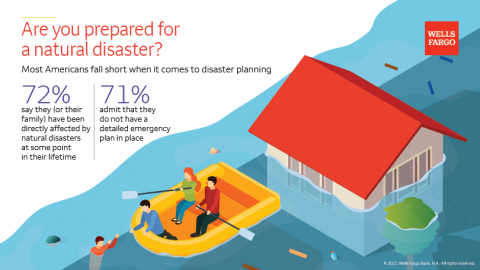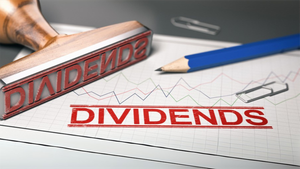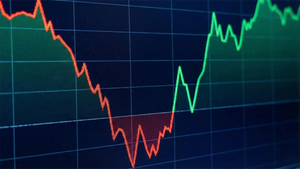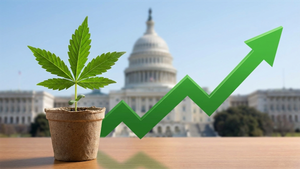Almost three quarters don’t have a detailed emergency plan
In a time when natural disasters are becoming more frequent, most Americans are not physically or financially prepared. According to a new Wells Fargo & Company survey, four in five Americans (84%) live in areas that have experienced some form of natural disaster in the past three years, and over half (54%) live in areas that have experienced severe natural disasters, specifically hurricanes, tornadoes, floods, wildfires or earthquakes. Furthermore, nearly three quarters of respondents (72%) say they or their families have been directly affected by natural disasters at some point in their lifetime. Nevertheless, most Americans (71%) admit they don’t have a detailed emergency plan in the event of a natural disaster.
This press release features multimedia. View the full release here: https://www.businesswire.com/news/home/20210922005085/en/

(Graphic: Wells Fargo)
Among those who do not have a detailed natural disaster emergency plan, 40% say it’s because they’ve never thought about making one, 35% say they are focused on more immediate issues, and 31% say they haven’t gotten around to it. Only 16% say they don’t know how to prepare.
“The survey affirms a lack of physical preparedness as well as financial readiness for emergencies for most people,” said Rullah Price, head of Public Affairs Resiliency & Enterprise Incident Communications. “Given that half of those surveyed said they would like their bank to proactively help them plan for a natural disaster, I believe there’s an opportunity for Wells Fargo to educate and inspire people to make some changes for the better – starting now.”
When asked about planning style:
- 40% described themselves as a Barely Covered planner who has very thin and non-specific emergency plans
- 39% called themselves a Good Enough planner who has adequate plans in place
- 16% called themselves an Avoider who has not thought at all about emergency planning
- Only 5% described themselves as a Super Planner who is prepared for every possible natural disaster and emergency
The national online survey of 2,226 adults was conducted by Ipsos on behalf of Wells Fargo Aug. 31-Sept. 3, 2021.
Plans often incomplete
The survey found that those who do have an emergency plan (29% of Americans) prioritize having food and water supplies (78%), emergency cash (63%), access to important documents (61%) and a planned transportation/evacuation route (59%). Items of slightly lower priority include a plan for their medical needs (54%), family communication plan (52%), shelter plan (49%) or plan for their pets (44%).
“Most people’s plans are lacking in detail. It’s necessary to really think through all the possible scenarios. For example, only a quarter of respondents have outlined specific plans for members in the household of different ages. This is incredibly important for vulnerable ones like children and seniors,” added Price.
Only half of all Americans (52%) say they would be prepared if a natural disaster left them without electricity for two weeks. Among those with an emergency plan in place, less than a quarter (23%) said they’d assigned responsibilities for helping others in their plan.
Most not financially prepared
In addition to lacking a physical plan, most Americans also are not financially prepared for disaster. The study found that less than half (44%) have started an emergency savings account, and many do not keep enough cash on hand. Two in five (39%) say they have no emergency cash in the house, and another 11% have $100 or less in cash at home.
“We are evolving to a cashless society—but during an emergency, cash is what’s needed,” said Price. “In times of natural disaster, you may not have easy access to an ATM, and credit cards may not work if electricity is out. It’s important to be prepared for all possible events.”
The study found that only two in five (43%) have a consolidated file of important records and receipts, safely stored digitally and in a waterproof, fireproof container. Slightly more than half (55%) have recently reviewed insurance policies to ensure they have the right types and amounts of coverage.
“It’s important to contact a qualified financial counselor to help organize your finances for an emergency,” said Price. “Less than a quarter of respondents have done this.”
Attention to details matter
“It was surprising to learn that less than a third (32%) of respondents have a go-bag packed in case of natural disaster and many of those with cars (43%) do not keep their gas tanks filled halfway for emergency evacuation,” said Price.
Additional findings on preparedness:
- Less than half (46%) have an emergency kit that includes supplies that will last for several days after a disaster for everyone living in their home.
- Just over half (54%) have a 2-week emergency food supply in their home.
- Two in five (38%) report that their important documents are not easy to find in their house.
- Only a third (31%) have documented possessions by taking photos and videos of their house and household items in case they need to make an insurance claim.
Communication is key
Although most Americans are likely to be directly affected by natural disasters at some point in their lifetime, only a third (32%) have had a conversation with family members about how they would locate each other if they were separated during such an event.
The survey revealed that only a third of parents (37%) have discussed the possibility of disasters with their school age children, only a third of parents (36%) have made plans for school age children in case the parents can’t get home, and just 13% have discussed disaster plans with their neighbors or community.
“There have already been multiple natural disasters, including wildfires, hurricanes, flooding, earthquakes and winter storms in the U.S. this year,” said Price. “Because a natural disaster can occur in any region at any time, it’s crucial to have a detailed emergency plan and communicate with your family how you will prepare and protect one another.”
About the Survey
Ipsos conducted a national online survey of 2,226 adults age 18+ on behalf of Wells Fargo. The poll was conducted Aug. 31-Sept. 3, 2021. The poll has a credibility interval of plus or minus 2.4 percentage points for all respondents.
About Ipsos
Ipsos is the world’s third largest Insights and Analytics company, present in 90 markets and employing more than 18,000 people. Founded in France in 1975, they serve more than 5000 clients across the world with 75 business solutions.
About Wells Fargo
Wells Fargo & Company (NYSE: WFC) is a leading financial services company that has approximately $1.9 trillion in assets, proudly serves one in three U.S. households and more than 10% of small businesses in the U.S., and is the leading middle market banking provider in the U.S. We provide a diversified set of banking, investment and mortgage products and services, as well as consumer and commercial finance, through our four reportable operating segments: Consumer Banking and Lending, Commercial Banking, Corporate and Investment Banking, and Wealth & Investment Management. Wells Fargo ranked No. 37 on Fortune’s 2021 rankings of America’s largest corporations. In the communities we serve, the company focuses its social impact on building a sustainable, inclusive future for all by supporting housing affordability, small business growth, financial health, and a low-carbon economy. News, insights, and perspectives from Wells Fargo are also available at Wells Fargo Stories. Additional information may be found at www.wellsfargo.com | Twitter: @WellsFargo.
News Release Category: WF-DAR
View source version on businesswire.com: https://www.businesswire.com/news/home/20210922005085/en/
Contacts
Media
Alfredo Padilla, 213.369.6122
alfredo.padilla@wellsfargo.com




